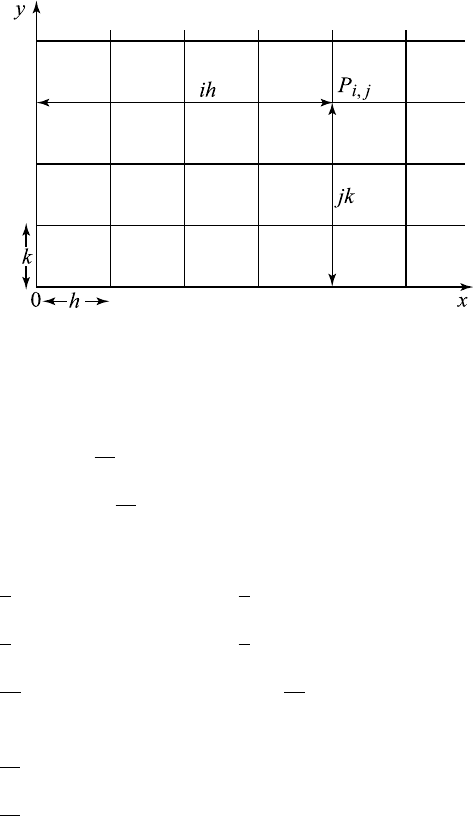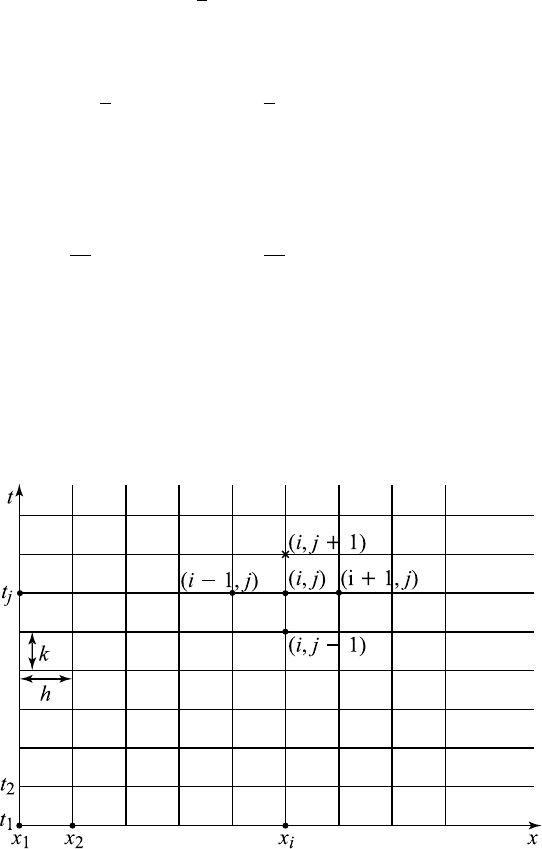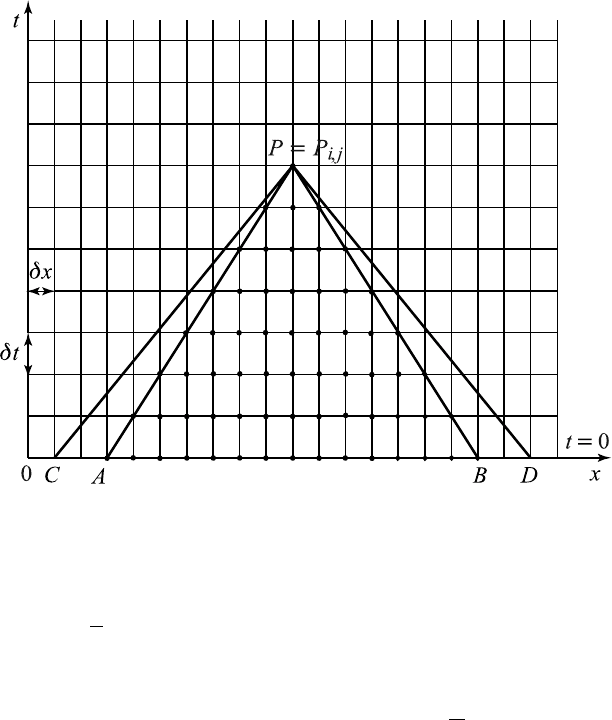Myint Tyn U., Debnath L. Linear Partial Differential Equations for Scientists and Engineers
Подождите немного. Документ загружается.


14
Numerical and Approximation Methods
“The strides that have been made recently, in the theory of nonlinear partial
differential equations, are as great as in the linear theory. Unlike the linear
case, no wholesale liquidation of broad classes of problems has taken place;
rather, it is steady progress on old fronts and on some new ones, the com-
plete solution of some special problems, and the discovery of some brand
new phenomena. The old tools – variation al methods, fixed point theorems,
mapping degree, and other topological tools have been augmented by some
new ones. Pre-eminent for discovering new phenomena is numerical exper-
imentation; but it is likely that in the future numerical calculations will be
parts of proofs.”
Peter Lax
“Almost everyone using computers has experienced instances where
computational results have sparked new insights.”
Norman J. Zabusky
14.1 Introduction
The p r eceding chapters have been devoted to the analytical treatment of
linear and nonlinear partial differential equations. Several analytical meth-
ods to find the exact analytical solution of these equations within simple
domains have been discussed. The boundary and initial conditi ons in these
problems were also relatively simple, and were expressible in simple math-
ematical form. In dealing with many equations arising from the modelling
of physical problems, the determination of such exact solutions in a simple
domain is a formidable task even when the boundary and/or initial data are
simple. It is then necessary to resort to numerical or appr oximation meth-
ods in order to deal with the problems that cannot be solved analytically. In

602 14 Numerical and Approximation Methods
view of the widespread accessibility of today’s high speed electronic com-
puters, numerical and appr oximation methods are becoming increasingly
important and useful in applications.
In this chapter some of the major numerical and approximation ap-
proaches to the solution of partial differential equations are d iscussed in
some detail. These include numerical methods based on finite difference ap-
proximations, variational methods, and the Rayleigh–Ritz, Galerkin, and
Kantorovich methods of approximation. The chapter also contains a large
section on analytical treatment of variational methods and the Euler–
Lagrange equations and their applications. A short section on the finite
element method is also included.
14.2 Finite Difference Approximations, Convergence,
and Stability
The Taylor series expansion of a function u (x, y) of two independent vari-
ables x and y is
u (x
i
+
h, y
j
)=u
i +
1,j
= u
i,j
+
h (u
x
)
i,j
+
h
2
2!
(u
xx
)
i,j
+
h
3
3!
(u
xxx
)
i,j
+ ..., (14.2.1ab )
u (x
i
,y
j
+
k)=u
i,j +
1
= u
i,j
+
k (u
y
)
i,j
+
k
2
2!
(u
yy
)
i,j
+
k
3
3!
(u
yyy
)
i,j
+ ..., (14.2.2ab)
where u
i,j
= u (x, y), u
i +
1,j
= u (x +
h, y), and u
i,j +
1
= u (x, y +
k).
We choose a set of uniformly spaced rectangles with vertices at P
i,j
with
coordinates (ih, jk), where i, j, are positive or negative integers or zero, as
shown in Figure 14.2.1. We denote u (ih, jk)byu
i,j
.
Using the above Taylor series expansion, we write approximate expres-
sions for u
x
at the vertex P
i,j
in terms of u
i,j
, u
i +
1,j
:
u
x
=
1
h
[u (x + h, y) − u (x, y)] ∼
1
h
(u
i+1,j
− u
i,j
)+O (h) , (14.2.3)
u
x
=
1
h
[u (x, y) − u (x − h, y)] ∼
1
h
(u
i,j
− u
i−1,j
)+O (h) , (14.2.4)
u
x
=
1
2h
[u (x + h, y) − u (x − h, y)] ∼
1
2h
(u
i+1,j
− u
i−1,j
)+O
h
2
.
(14.2.5)
These expressions are called the forward first difference, backward first
difference,andcentral first difference of u
x
, respectively. The quantity O (h)
or O
h
2
is known as the truncation error in this discretization process.

14.2 Finite Difference Approximations, Convergence, and Stability 603
Figure 14.2.1 Uniformly spaced rectangles.
A similar approximate result for u
xx
at the vertex P
i,j
is
u
xx
=
1
h
2
[u (x + h, y) − 2 u (x, y)+u (x − h, y)]
∼
1
h
2
[u
i+1,j
− 2 u
i,j
+ u
i−1,j
]+O
h
2
. (14.2.6)
Similarly, the approximate formulas for u
y
and u
yy
at P
i,j
are
u
y
=
1
k
[u (x, y + k) − u (x, y)] ∼
1
k
(u
i,j+1
− u
i,j
)+O (k) , (14.2.7)
u
y
=
1
k
[u (x, y) − u (x, y − k)] ∼
1
k
(u
i,j
− u
i,j−1
)+O (k) , (14.2.8)
u
y
=
1
2k
[u (x, y + k) − u (x, y − k)] ∼
1
2k
(u
i,j+1
− u
i,j−1
)+O
k
2
,
(14.2.9)
u
yy
=
1
k
2
[u (x, y + k) − 2 u (x, y)+u (x, y − k)]
∼
1
k
2
[u
i,j+1
− 2u
i,j
+ u
i,j−1
]+O
k
2
. (14.2.10)
All these difference formulas are extremely useful in finding numerical
solutions of first or second order partial differential equations.
Suppose U (x, y) represents the exact solution of a partial differential
equation L (U) = 0 with independent variables x an d y,andu
i,j
is the
exact solution of the corresponding finite difference equation F (u
i,j
)=0.
Then, the finite difference scheme is said to be convergent if u
i,j
tends to
U as h and k tend to zero. The difference, d
i,j
≡ (U
i,j
− u
i,j
) is called the
cummulative truncation (or discretization) error.
This error can generally be minimized by decreasing the grid sizes h
and k. However, this error depends not only on h and k, but also on the
604 14 Numerical and Approximation Methods
number of terms in the truncated series which is used to approximate each
partial derivative.
Another kind of error is introduced when a parti al differential equation
is ap proximated by a finite difference equation. If the exact finite difference
solution u
i,j
is replaced by the exact solution U
i,j
of the par tial differential
equation at the grid points P
i,j
, then the value F (U
i,j
) is called the local
truncation error at P
i,j
. The finite difference scheme and the partial differ-
ential equation are said to be consistent if F (U
i,j
) tends to zero as h and
k tend to zero.
In general, finite difference equations cannot be solved exactly because
the numerical computation is carried out only up to a finite number of
decimal places. Consequently, another kind of error is introduced in the
finite difference solution duri ng the actual process of computation. This
kind of error is called the round-off error, and it also depends upon the
type of computer used. In practice, the actual computation al solution is
u
∗
i,j
, but not u
i,j
, so that the difference r
i,j
=
u
i,j
− u
∗
i,j
is the round-
off error at the grid point P
i,j
. In fact, this error is introduced into the
solution of the finite difference equation by round-off errors. In reality, the
round-off error depends mainly on the actual computational process and
the finite difference itself. In contrast to the cummulative truncation error,
the round-off error cannot be made small by allowing h and k to tend to
zero.
Thus, the total error involved in the finite difference analysis at the
point P
i,j
is given by
U
i,j
− u
∗
i,j
=(U
i,j
− u
i,j
)+
u
i,j
− u
∗
i,j
= d
i,j
− r
i,j
. (14.2.11)
Usually the discretization error d
i,j
is bounded when u
i,j
is bounded
because the value of U
i,j
is fixed for a given partial differential equation
with the prescribed boundary and initial data. This fact is used or assumed
in order to introduce the concept of stability. The finite difference algo-
rithm is said to be stable if the round-off errors are sufficiently small for
all i as j →∞, that is, the growth of r
i,j
can be controlled. It should be
pointed out again that the round-off error depends not only on the actual
computational process and the type of computer used, but also on the finite
difference equation itself. Lax (1954) proved a remarkable theorem which
establishes the relationship between consistency, stability, and convergence
for the finite difference algorithm.
Theorem 14.2.1. (Lax’s Equivalence Theorem). Given a properly posed
linear initial-value problem and a finite difference approxi mation to it that
satisfies the consistency criterion, stability is a necessary and sufficient
condition for convergence.

14.3 Lax–Wendroff Explicit Method 605
Von Neumann’s Stability Method
This method is essentially based u pon a finite Fourier series. It expresses
the initial errors on the line t = 0 in terms of a finite Fourier series and then
examines the propagation of errors as t →∞. It is convenient to denote
the error fu nction by e
r,s
instead of e
i,j
so that e
r,s
gives the initial values
e
r,0
= e (rh)=e
r
on the line t = 0 between x = 0 and x = l,wherer =0,
1, 2, ..., N and Nh = l. The finite Fourier series expansion of e
r
is
e
r
=
N
n=0
A
n
exp (inπx/l)=
N
n=0
A
n
exp (iα
n
rh) , (14.2.12)
where α
n
=(nπ/l), x = rh,andA
n
are the Fourier coefficients which are
determined from the (N + 1) equations (14.2.12).
Since we are concerned with the linear finite difference scheme, errors
form an additi ve system so that the total error can b e found by the superp o-
sition principle. Thus, it is sufficient t o consider a single term exp (iαrh)in
the Fourier series (14.2.12). Following the method of separation of variables
commonly used for finding the analytical solu tion of a partial differential
equation, we seek a separable solution of the fini te difference equation for
e
r,s
in the form
e
r,s
=exp(iαrh + βsk)=exp(iαrh) p
s
(14.2.13)
which reduces to exp (iαrh)ats =0(t = sk = 0), where p =exp(βk), and
β is a complex constant. This shows that the error is bounded as (t →∞)
provided that
|p|≤1 (14.2.14)
is satisfied. This condition is found to be necessary and sufficient for the
stability of the finite difference algorithm.
14.3 Lax–Wendroff Explicit Method
To describe this method, we consider the first-order conservation equation
∂u
∂t
+ c
∂u
∂x
= 0 (14.3.1)
where u ≡ u (x, t) is some physical function of space variable x and time t.
This equation occurs frequently in applied mathematics.
Lax and Wendroff use the Taylor series expansion in t in the form
u
i,j+1
= u
i,j
+ k (u
t
)
i,j
+
k
2
2!
(u
tt
)
i,j
+
k
3
3!
(u
ttt
)
i,j
+ ..., (14.3.2)

606 14 Numerical and Approximation Methods
where k ≡ δt.
The partial derivatives in t in (14.3.2) can easily be eliminated by using
u
t
= −cu
x
so that (14.3.2) becomes
u
i,j+1
= u
i,j
− ck(u
x
)
i,j
+
c
2
k
2
2
(u
xx
)
i,j
− .... (14.3.3)
Replacing u
x
, u
xx
by the central difference formulas, (14.3.3) becomes
u
i,j+1
= u
i,j
−
ck
2h
(u
i+1,j
− u
i−1,j
)+
1
2
ck
h
2
(u
i+1,j
− 2 u
i,j
+ u
i−1,j
) ,
or
u
i,j+1
=
1 − ε
2
u
i,j
+
ε
2
(1 + ε) u
i−1,j
−
ε
2
(1 + ε) u
i+1,j
+ O
ε
3
,(14.3.4)
where ε =(ck/h). This is called the Lax–Wendroff second-order finite dif-
ference scheme; it has been widely used to solve first-order hyperbolic equa-
tions.
Von Neumann criterion (14.2.14) can be applied to investigate the sta-
bility of the Lax–Wendroff scheme. It is noted that the error function e
r,s
given by (14.2.13) satisfies the finite difference equation (14.3.4). We then
substitute (14.2.13) into (14.3.4) and cancel common factors to obtain
p =
1 − ε
2
+
ε
2
(1 + ε) e
−iαh
− (1 − ε) e
iαh
!
=1− 2 ε
2
sin
2
αh
2
− 2iε sin
αh
2
cos
αh
2
,
so that
|p|
2
=1− 4ε
2
1 − ε
2
sin
4
αh
2
. (14.3.5)
According to the von Neumann criterion, the Lax–Wendroff scheme
(14.3.4) is stable as t →∞if |p|≤1, which gives 4ε
2
1 − ε
2
≥ 0, that is,
0 <ε≤ 1.
The local truncation error of the Lax–Wendroff equation (14.3.4) at P
i,j
is
T
i,j
=
1
k
(u
i,j+1
− u
i−1,j
)
which is, by (14.2.2a) and (14.2.1b) with ck = h (ε = 1),
=(u
t
+ cu
x
)
i,j
+
k
2
u
tt
− c
2
u
xxx
i,j
+
k
2
6
u
ttt
+ c
3
u
xxx
i,j
+ O
(ck)
3
.
(14.3.6)

14.3 Lax–Wendroff Explicit Method 607
The first two terms on the right side of (14.3.6) vanish by equation (14.3.1)
so that the local truncation error becomes
T
i,j
=
1
6
k
2
u
ttt
+ ch
2
u
xxx
i,j
. (14.3.7)
Another approximation to (14.3.1) with first-order accuracy is
1
k
(u
i,j+1
− u
i,j
)+
c
h
(u
i,j
− u
i−1,j
)=0. (14.3.8)
A final explicit scheme for (14.3.1) is based on the central difference ap-
proximation.Thisschemeiscalledtheleap frog algorithm. In this method,
the finite difference approximation to (14.3.1) is
1
2k
(u
i,j+1
− u
i,j−1
)+
c
2h
(u
i+1,j
− u
i−1,j
)=0,
or,
u
i,j+1
= u
i,j−1
− ε (u
i+1,j
− u
i−1,j
) . (14.3.9)
As shown in Figure 14.3.1, this equation shows that the value of u at
P
i,j+1
is computed from the previously computed values at three grid points
at two previous time steps.
Figure 14.3.1 Grid system for the leap frog algorithm.

608 14 Numerical and Approximation Methods
14.4 Explicit Finite Difference Methods
(A) Wave Equation and the Courant–Friedrichs–Lewy
Convergence Criterion
The method of characteristics provides the most convenient and accurate
procedure for solving Cauchy problems involving hyperbolic equations. One
of the main advantages of this method is that discontinuities of the initial
data propagate into the solution domain along the characteristics. However,
when the initial data are discontinuous, the finite difference algorithm for
the hyperbolic systems is not very convenient. Problems concerning hyper-
bolic equations with continuous initial data can be solved successfully by
finite difference methods with rectangular gr id systems.
A commonly cited pr oblem is the propagation of a one-dimensional wave
governed by the system
u
tt
= c
2
u
xx
, −∞ <x<∞,t>0, (14.4.1)
u (x , 0) = f (x) ,u
t
(x, 0) = g (x) for all x ∈ R. (14.4.2)
Using a rectangular grid system with h = δx, k = δt, u
i,j
= u (ih, jk),
−∞ <x<∞,and0≤ j<∞, the central difference approximation to
equation (14.4.1) is
1
k
2
(u
i,j+1
− 2 u
i,j
+ u
i,j−1
)=
c
2
h
2
(u
i+1,j
− 2 u
i,j
+ u
i−1,j
) ,
or,
u
i,j+1
= ε
2
(u
i+1,j
+ u
i−1,j
)+2
1 − ε
2
u
i,j
− u
i,j−1
, (14.4.3)
where ε ≡ (ck/h), and is often called the Courant parameter. This explicit
formula allows us to determine the approximate values at the grid points
on the lines t =2k,3k,4k, ..., when the grid values at t = k have been
obtained.
The approximate values of the initial data on the line t = 0 are
u
i,0
= f
i
,
1
2k
(u
i,1
− u
i,−1
)=g
i,0
(14.4.4)
so that the second result gives
u
i,−1
= u
i,1
− 2kg
i,0
. (14.4.5)
When j = 0 in (14.4.3) and (14.4.5) is used, we obtain
u
i,1
=
1
2
ε
2
(f
i−1
+ f
i+1
)+
1 − ε
2
f
i
+ kg
i,0
. (14.4.6)
This result determines grid values on the line t = k.

14.4 Explicit Finite Difference Methods 609
Figure 14.4.1 Computational grid systems and characteristics.
The value of u at P
i,j+1
is obtain ed in terms of its previously calculated
values at P
i +
1,j
, P
i,j
,andP
i,j−1
, which are determined from previously
computed values on th e lines t =(j − 1) k,(j − 2) k,(j − 3) k. Thus, the
computation from the lines t = 0 and t = k suggests that u at P
i,j
will rep-
resent a function of the values of u within the domain bounded by the lines
drawn back toward t =0fromP whose gradients are (+
ε) as shown in Fig-
ure 14.4.1. Thus the triangular regions PAB, PCD represent the domains
of dependence at P of the solutions of the finite difference equation (14.4.3)
and the differential equation (14.4.1). By analogy with real characteristic
lines PC and PD of the differential equation, the straight lines PA and
PB are called the numerical characteristi cs. Thus, it f ollows from Figure
14.4.1 that ∆P AB lies inside ∆P CD, which means that the soluti on of the
finite difference system at P would remain unchanged even when the initial
data along PA and PB are changed. Courant, Friedrichs and Lewy (CFL,
1928) proved that the solution of the finite difference system converges to
that of the differential equation system as h and k tend to zero provided
that the domain of dependence of the difference equation lies inside that of
the partial differential equation. This condition for convergence is known
as the CFL condition,whichmeans1/c ≥ k/h,thatis,0<ε≤ 1.
If the Courant parameter is ε = 1, equation (14.4.3) reduces to a simple
form

610 14 Numerical and Approximation Methods
u
i,j+1
= u
i+1,j
+ u
i−1,j
− u
i,j−1
. (14.4.7)
As shown in Figure 14.3.1, this equation shows that the value of u at
P
i,j+1
is computed from the previously computed values at three grid points
at two previous time steps. This is called the leap frog algorithm.
From equation (5.3.4) in Chapter 5, we know that the solution of the
Cauchy problem for the wave equation has the form
u (x , t)=φ (x + ct)+ψ (x − ct) ,
where the functions φ and ψ represent waves propagating without changing
shape along the negative and positive x directions with a constant speed
c. The lines of slope (dt/dx)=+
(1/c)inthex − t plane, which trace the
progress of the waves, are known as the characteristics of the wave equation.
In terms of a grid p oint (x
i
,t
j
), the above solution has the form
u
i,j
= φ (x
i
+ ct
j
)+ψ (x
i
− ct
j
) . (14.4.8)
It follows from Figure 14.3.1 that x
i
= x
1
+(i − 1) h and t
j
= t
1
+
(j − 1) k so that (14.4.8) takes the f or m
u
i,j
= φ (α + ih + jck)+ψ (β + ih − jck) , (14.4.9)
where
α =(x
1
− h)+c (t
1
− k) ,β=(x
1
− h) − c (t
1
− k) .
Since ε =1,ck = h, solution (14.4.9) becomes
u
i,j
= φ (α +(i + j) h)+ψ (β +(i − j) h) .
This satisfies equation (14.4.7). It follows that the leap frog metho d
gives the exact solution of the partial differential equation (14.4.1).
We apply von Neumann stability analysis to investigate the stability of
the above numerical method for the wave equation. We seek a separable
solution of the error function e
r,s
as
e
r,s
=exp(iαrh) p
s
, (14.4.10)
where p =exp(βk). This function satisfies the finite difference equation
(14.4.3). Substituting (14.4.10) into (14.4.3) and cancelling the common
factors, we obtain th e quadratic equation for p
p
2
− 2 bp+1=0, (14.4.11)
where b =1− 2ε
2
sin
2
(αh/2), ε =(ck/h), and b ≤ 1 for all real ε and α.
This quadratic equation has two complex roots p
1
and p
2
if b
2
< 1. Since
p
1
·p
2
= 1, it follows that on e of the roots will always have modulus greater
